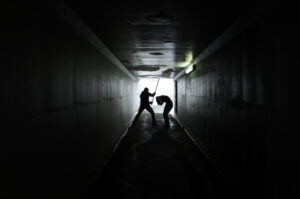The earthquake destroyed a vast area around Aleppo and killed 230,000 – Aleppo (modern name Halab)
In 1138, a deadly earthquake destroyed the city of Aleppo and the area around it. This city is set in a nest of fault lines and earthquakes have always been a feature of life. A large earthquake of intensity greater than 7 hit the coastal area immediately south of Aleppo five hundred years earlier. Its impact was felt over a large part of the eastern Mediterranean and it was accompanied by a tsunami. The East Anatolian Fault line passes through Aleppo and, as it moves, it gives rise to a series of earthquakes over time. Additional disruptions come from the westward movement of the area as a whole under pressure from the Arabian Tectonic Plate. The earthquake of 1138 completely destroyed a vast area in and around Aleppo, now called Halab, and jolted places two hundred miles from the city. The death toll was 230,000, making it one of the five deadliest earthquakes in recorded history. There were several small aftershocks and, twenty years later, another very strong earthquake.
Aleppo has been settled for more than three thousand years. Initially it was the territory of the Hittites, then the land of the Assyrian and Persian empires for almost a thousand years until the Greek Empire of Alexander the Great captured it. The Romans were the next owners of this part of the Middle East and, after them, Arab and Ottoman masters until the fall of the latter in 1923. The key location of Aleppo on trade routes between Europe and Africa and Asia always made it a target of invaders. Around the year 1100, the city came under siege from the Crusaders on two occasions but they failed to capture it. The Mongol armies swept over it in the second half of the thirteenth century, destroying everything as effectively as any earthquake might do. Today the city is a large, modern, urban center of two to three million people, the second biggest city of Syria next to Damascus. It stands on the same site as it occupied for thousands of years; thus its rich history lies hidden beneath many buildings.
Aleppo is in a location that is extremely hot in summer but its elevation of more than a thousand feet above the surrounding plain, coupled with prevailing strong breezes, have always kept summer high temperatures below 110 degrees. Its modern name, Halab, is based on an ancient word for milk and traditions trace this name to the time of Abraham who, it is said, stopped here for a time on his journey to the Promised Land and grazed his cows in the area around the city. The traditional routes along the valleys of the Euphrates and Tigris and down the eastern Mediterranean coast make that a feasible story. Today, this ancient link with the Bible is reflected in a large Christian population in Aleppo, about 30 percent of the total, probably the largest concentration in any Middle East country, appropriately identified by the street called “Narrow.” Another link with the Christian past is found in the Citadel mound. This place was a medieval castle, partially an imitation of the Crusader castles that were built all over the Middle East at that time. The crusaders brought with them the castle-building technology of Western Europe and in the years after they left the Middle East their technology is visible in the castles they abandoned. The castle in Aleppo is an excellent example of their work.
In addition to Christians, Aleppo had also from the very earliest times housed a big Jewish population. Their great synagogue held an ancient codex, now known as the Aleppo Codex, and it was dated in recent times as belonging to the ninth century. It somehow survived the catastrophes of the intervening centuries and is now housed in Jerusalem. There are other buildings too that define both its history and Aleppo’s present place within Syria. A cathedral that was built in Roman times under the auspices of Saint Helena, mother of Constantine the Great is regarded as the burial place of John the Baptist’s father. It was rebuilt in recent times. During the Crusades, when the invaders pillaged the surrounding countryside, the city’s chief judge converted Saint Helena’s cathedral into a mosque. Subsequently, it became a religious school. Aleppo’s physical location defined its role through the centuries. It was a trading center. It maintained that role for a very long time, until Europeans began to use the Cape route to India and later the shorter route through the Suez Canal and Red Sea.























1 thought on “Aleppo Earthquake – Syria – 1138 AD”
This article was a great source of information for my project!